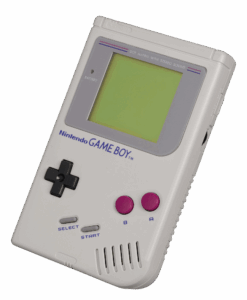
The original Nintendo Game Boy was an 8-bit handheld console developed by Nintendo Research & Development 1 and released in 1989. Despite being less technologically advanced than its competitors, the Game Boy dominated the market with its affordability, long battery life, and compelling software library, ultimately becoming a cultural icon.
Conception and development
- Design philosophy: The Game Boy was conceived under the direction of Gunpei Yokoi, a key Nintendo creative who developed the philosophy of “lateral thinking with withered technology”. This meant using mature, affordable technology in innovative ways instead of pursuing the latest, most expensive hardware. This approach prioritized reliability and affordability over cutting-edge features.
- Hardware debates: Yokoi initially envisioned a simple device, but his assistant, Satoru Okada, pushed for a more advanced system with interchangeable cartridges, similar to a portable NES. Okada’s vision ultimately won out in a decisive meeting.
- Screen challenges: The team had significant trouble finding a suitable screen. Early monochrome displays suffered from severe ghosting issues, leading to the project being mocked internally as “DameGame” (hopeless game). Nintendo president Hiroshi Yamauchi briefly canceled the project. Yokoi, however, continued to refine the design and eventually secured a new super-twisted nematic (STN) display from Sharp, which offered better viewing angles but increased production costs.
- Bundling the game: While Super Mario Land was developed as the flagship title, Nintendo of America was convinced to bundle the system with Tetris instead. This was a crucial decision, as the universally appealing puzzle game broadened the handheld’s audience beyond just young boys.
Launch and market domination
- Launch dates and price:
- Japan: April 21, 1989, at ¥12,500.
- North America: July 31, 1989, at $89.99.
- Europe: September 28, 1990.
- Competitors: Upon its release, the Game Boy faced competition from more powerful, full-color rivals like the Atari Lynx and the Sega Game Gear.
- The battery advantage: The Game Boy’s monochrome screen and simpler hardware design meant it could run for up to 30 hours on four AA batteries, a massive advantage over the battery-hungry competition.
- Instant success: Despite initial mixed reviews over its display, the Game Boy was an instant commercial hit. The initial 300,000 units sold out in Japan within two weeks, and sales reached one million in the US within weeks of its release.
Revisions and legacy
- Later models: The Game Boy’s incredible sales kept it relevant for over a decade. Nintendo introduced several hardware revisions to extend its lifespan:
- “Play It Loud!” (1995): Introduced several new case colors.
- Game Boy Pocket (1996): A smaller, lighter model with an improved black-and-white screen, though with a shorter battery life.
- Game Boy Light (1998): A Japan-exclusive model with a backlit screen.
- Game Boy Color (1998): The official successor added a color screen but remained backward-compatible with original Game Boy games.
- Total sales: The original Game Boy and Game Boy Color sold a combined total of 118.69 million units worldwide by the time of its discontinuation in 2003, making the line one of the best-selling gaming systems of all time.
- Long-term impact:
- Cultural Icon: The Game Boy helped popularize portable gaming and is often cited as a gateway device that introduced a generation to video games.
- Pokémon: The massive success of the Pokémon franchise further fueled Game Boy sales in the mid-to-late 1990s and demonstrated the power of the Game Link Cable for multiplayer gaming.
- Modern influence: The Game Boy’s legacy can be seen in the success of subsequent Nintendo handhelds and the continued growth of the portable gaming market.